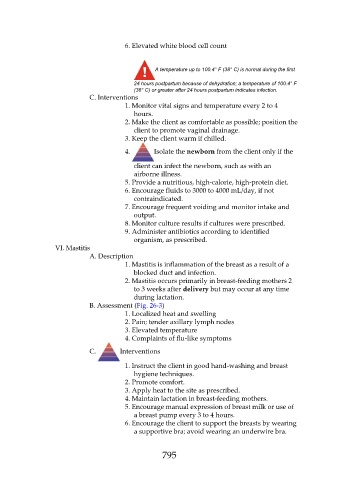Page 795 - Saunders Comprehensive Review For NCLEX-RN
P. 795
6. Elevated white blood cell count
A temperature up to 100.4° F (38° C) is normal during the first
24 hours postpartum because of dehydration; a temperature of 100.4° F
(38° C) or greater after 24 hours postpartum indicates infection.
C. Interventions
1. Monitor vital signs and temperature every 2 to 4
hours.
2. Make the client as comfortable as possible; position the
client to promote vaginal drainage.
3. Keep the client warm if chilled.
4. Isolate the newborn from the client only if the
client can infect the newborn, such as with an
airborne illness.
5. Provide a nutritious, high-calorie, high-protein diet.
6. Encourage fluids to 3000 to 4000 mL/day, if not
contraindicated.
7. Encourage frequent voiding and monitor intake and
output.
8. Monitor culture results if cultures were prescribed.
9. Administer antibiotics according to identified
organism, as prescribed.
VI. Mastitis
A. Description
1. Mastitis is inflammation of the breast as a result of a
blocked duct and infection.
2. Mastitis occurs primarily in breast-feeding mothers 2
to 3 weeks after delivery but may occur at any time
during lactation.
B. Assessment (Fig. 26-3)
1. Localized heat and swelling
2. Pain; tender axillary lymph nodes
3. Elevated temperature
4. Complaints of flu-like symptoms
C. Interventions
1. Instruct the client in good hand-washing and breast
hygiene techniques.
2. Promote comfort.
3. Apply heat to the site as prescribed.
4. Maintain lactation in breast-feeding mothers.
5. Encourage manual expression of breast milk or use of
a breast pump every 3 to 4 hours.
6. Encourage the client to support the breasts by wearing
a supportive bra; avoid wearing an underwire bra.
795

